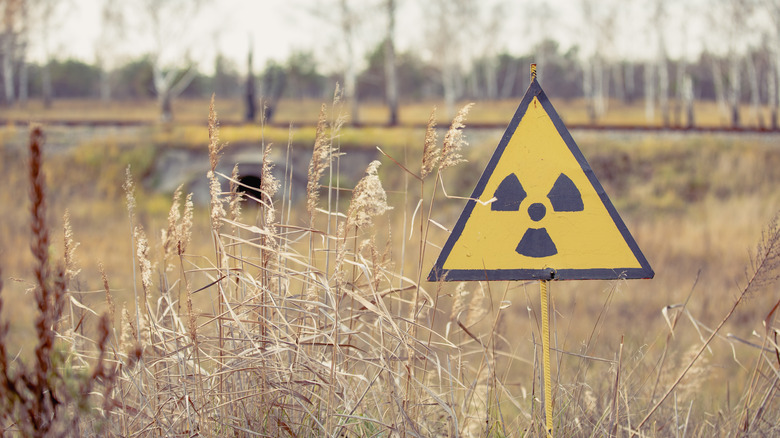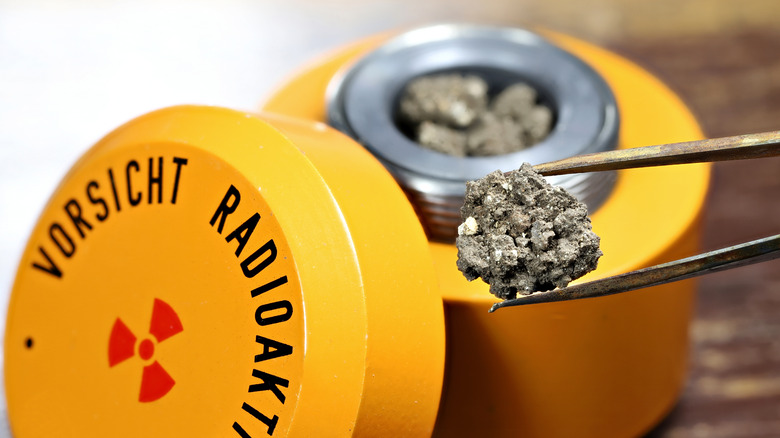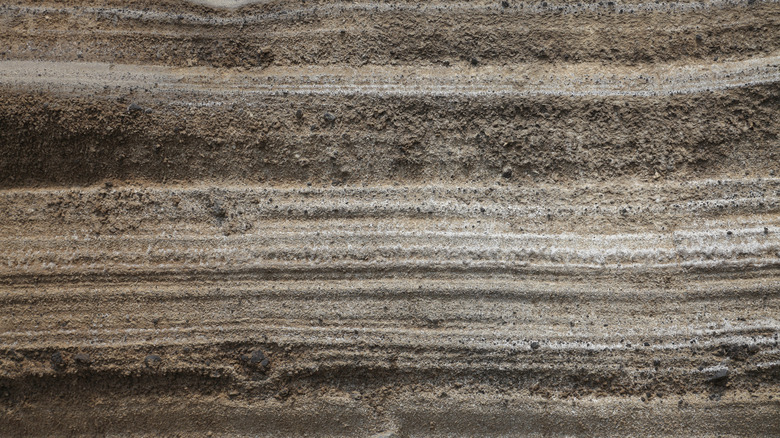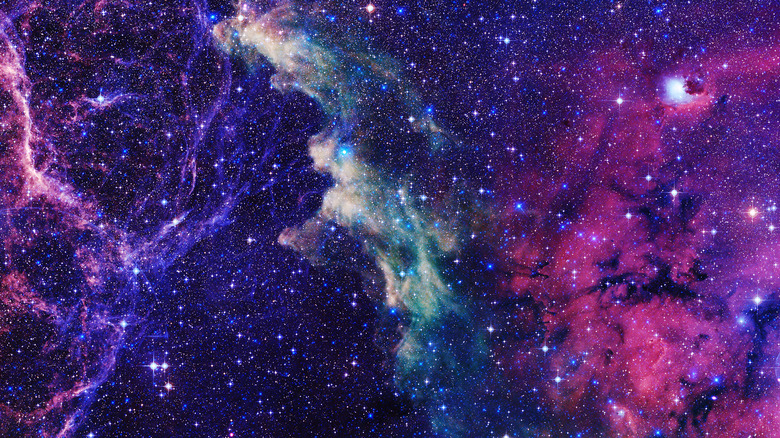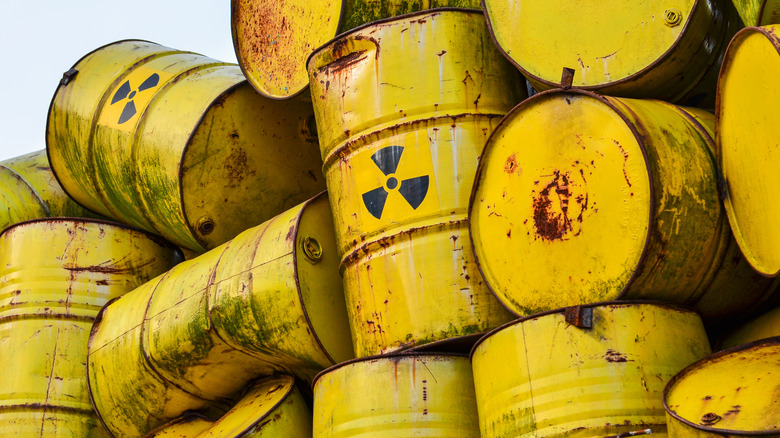The 2 Billion Year Old Nuclear Reactor That Exists In Africa
When we generally think of nuclear reactors, we think of the ones created by humans. They're anthropogenic and technically artificial, designed and manufactured specifically to slow the process of nuclear fission, producing energy as an alternative to coal power (via the U.S. Office of Nuclear Energy). But surprisingly, nuclear reactors aren't solely human-made. So far, only one naturally occurring nuclear reactor has ever been discovered as of this writing, but the keywords here are "naturally occurring." Located in Gabon, Africa, this natural reactor has puzzled scientists and appears to have been created under a unique set of circumstances unlikely to be replicated anywhere else on Earth.
One of the main concerns with nuclear reactors is the harmful, radioactive waste they produce. While nuclear energy is often cleaner than coal burning, the waste produced from it remains radioactive for millions of years. According to the Environmental Protection Agency, being able to safely store nuclear waste is one of the most troubling things that nuclear scientists must face. Studying this unique formation has led researchers to a greater understanding of nuclear fission and possible techniques that could be used to find ways to safely store nuclear waste in the near future.
In 1972, scientists made a startling discovery
In 1972, French scientists took samples of uranium ore from a mine located in the central African country of Gabon, in order to test its uranium contents, as Scientific American noted in a 2011 write-up of what eventually ensued. For the uninitiated, uranium ore is a naturally radioactive material comprised of three different forms of the element's isotopes — the most common being uranium-238, the rarest being uranium-234, and the last, uranium-235, being uniquely fascinating.
On its own, uranium-235 is especially of interest to nuclear scientists because of its ability to sustain nuclear chain reactions, which can subsequently create enough "explosive potential" for things like nuclear bombs, per Live Science. The resulting decay of a nuclear chain reaction by way of the isotope can also create a reaction by the three neutrons uranium-235 emits during this process — one which nuclear scientists can use as an alternative, cleaner power source to more pollutant ones like coal-burning.
All in all, this process was previously thought to be only possible by way of a technically synthetic (or human-made) process. So when scientists in 1972 found a clear variance in depletion levels in the uranium ore isotope collected from the mine found in the region of Oklo, Gabon, it seemed to signal one thing: It laid bare the possibility that a nuclear reactor could organically occur in nature, per Scientific American.
Scientists realized the uranium had some huge abnormalities
When the French scientists began to examine the uranium samples mined in Gabon, they expected to find around 0.72% of uranium-235 in the ore. As Scientific American pointed out, this percentage is the same found in other samples collected from places around the globe, as well as from the Earth's moon and from studied pieces of meteorite. Instead, the sample contained 0.717% of uranium-235. For many this 0.003% discrepancy would seem insignificant — but as Scientific American explained, this was hardly the case. It signaled a total of 440 pounds of missing uranium-235 from the Gabon mine. So how did this happen? And what could have caused it?
Thanks to prior research about the process of the isotope's decay, the scientists in 1972 put together that the missing percentage had undergone nuclear fission, per Scientific American. This was the first (and as of this writing, only) discovery of a naturally created nuclear reactor. After combing the mines for other possible reactors, 16 were unearthed, and the area and its scientific treasures were named the Oklo-reactor. (Unfortunately, as Scientific American noted, all 16 were eventually destroyed by mining.) However, the question remained: How was this naturally occurring nuclear reactor created?
Area conditions led to a nuclear fission process
As Forbes wrote in 2018, scientists believed (and, by all appearances, still believe) that the area around the Oklo-reactor created the perfect conditions for nuclear fission to naturally occur billions of years ago. Two main factors contributed to this. One was the way the rocks in the area weathered, per Forbes. This subsequently allowed the uranium in the mine to concentrate to such a degree that it could start a nuclear chain reaction organically. While the uranium ore would have originally been spread out in the sediments in the area, this weathering would have caused lighter sediments to be swept away, leading to more uranium ore in the same exact place.
The second condition that allowed for a sustained natural nuclear reaction was natural groundwater in the area which trickled through the mine's faults and cracks. This, essentially, created a cooling area, or "coolant," that combated any heat caused by the nuclear reactions in the ore. This allowed the Oklo-reactor to sustain a slow and stable nuclear fission reaction. According to Scientific American, if it weren't for these two conditions, the uranium ore might never have decayed in the first place, would have done so too quickly, or would never have been detectable by the scientists who discovered it in 1972.
The natural reactor has been around for billions of years
As Forbes noted in their own coverage of the Oklo-reactor, scientists dated its formation back to roughly 2 billion years ago. This timeframe made sense due to an admixture of factors. Per Scientific American, the increase of oxygen in the Earth's atmosphere allowed for the uranium to potently concentrate. It also enabled water flow in order to deposit uranium into local sandstone and siltstone, both of which are characterized as more porous and permeable in nature. According to Forbes, thanks to microbial activity from the world's first microscopic organisms, these uranium deposits were able to concentrate from there. Lastly, tectonic activity at this time buried these deposits underground, into the Earth's crust. Cue: uranium decay and the nuclear fission process.
After its initial start billions of years ago, the nuclear fission process in the Oklo-reactor went on for roughly hundreds of thousands of years, all thanks to the mine's groundwater coolant, and eventually slowed to a stop. Per Forbes, the only evidence left of the natural reactor's activity was, quite literally, in the elements — specifically, traces of barium and the aforementioned uranium-235 isotopes discovered in the early 1970s. But while the nuclear reactor's activity long ago ceased, it's still giving insights into not only nuclear reactions as a whole but into creating better ways to dispose of nuclear waste.
The Oklo-reactor might hold the key to nuclear waste disposal
During the decay of uranium in the Oklo-reactor, large quantities of radioactive plutonium and cesium were produced. Both of these harmful compounds, which can be highly dangerous to both living organisms, eventually decayed into harmless barium. As Forbes explained, none of the harmful radioactivity from either the plutonium or cesium leaked into the environment around the area near the Olko-reactor. This meant that the radioactive elements were safely contained. For scientists, figuring out how this safe containment could naturally occur became the main focal point of studying the reactor.
In 2018, scientists who studied the Oklo-reactor published peer-reviewed findings that detailed how this was able to occur (via PNAS). Radioactive plutonium and cesium didn't leak into the environment because they became coated in ruthenium, which in turn shielded radioactive particles from permeating the area. Thanks to this, the ruthenium stabilized possible exposure to radioactivity — and as Forbes noted, the possibility of further studying this as a feasible application to nuclear waste disposal today could help us use nuclear energy as safely and as efficiently as possible until cleaner forms of energy can be implemented worldwide.
